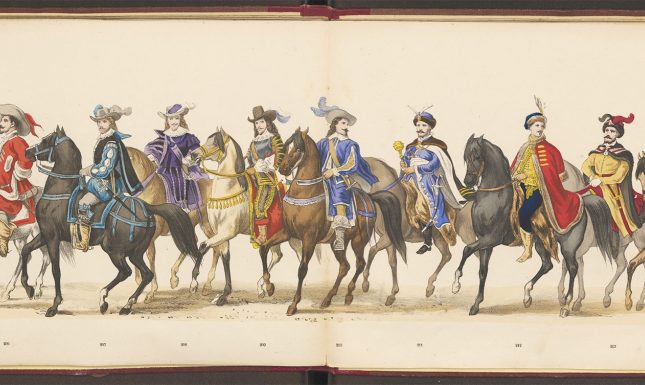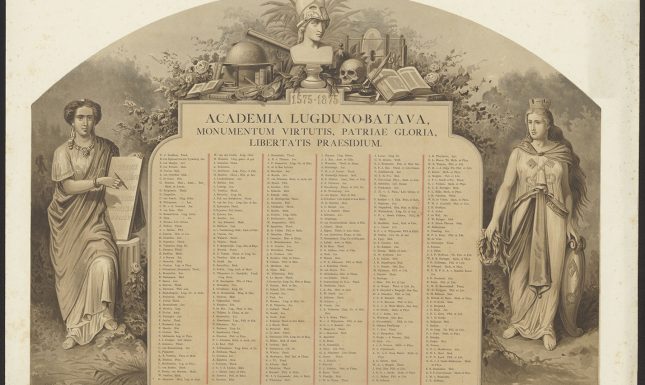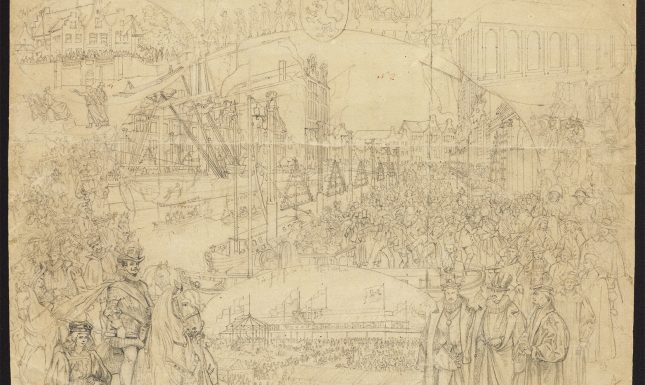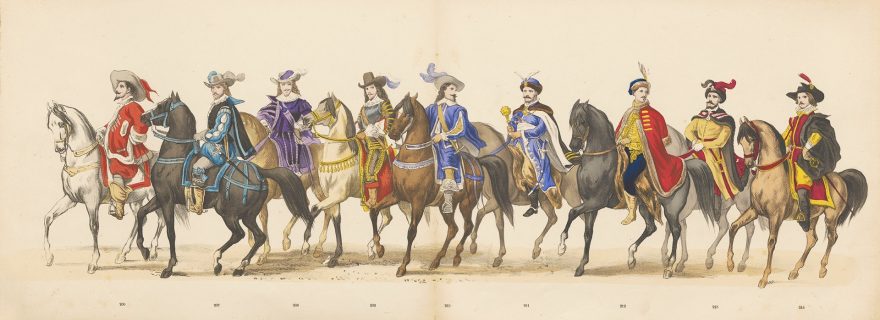Leiden University’s third centenary and jubilee (1875)
The fifteenth of June 1875 was a pleasant and warm day. Some menacing clouds threatened to throw a spanner in the works, but luckily the rain never came. Fortunate for the crowds gathering in Leiden, as on this day, Leiden University celebrated its three hundredth anniversary.
Traditionally, centenary celebrations were held during the ‘Dies’ of the university, on February 8th, but this time, the praesidium had decided to postpone the celebrations until the start of summer, so the weather would be better and more visitors from outside the city would be able to join the celebrations. The visitors came, in large numbers. Major newspapers reported the large number of trains stopping at Leiden Central Station that day, bringing attendees from all over the country. Scientists, scholars, and other researchers first and foremost, of course, visiting from other university cities and abroad. A large contingent of visitors had arrived earlier, like Leiden alumni, who had attended a speech by Nicolaas Beets on 14 June.
A real highlight on 15 June was the masquerade, organised by students of the Leiden Student Corps. They paraded the streets of Leiden dressed in extravagant outfits, and received ample attention, for example from the Dutch Royal Family. Earlier masquerades had depicted triumphant entrances by generals and governors, but in 1875 organisers chose to depict a cross-section of history. Every famous academic, minister and dignitary that had ever been affiliated with Leiden University walked or rode through the streets in procession, starting with the founding of the university in 1575 and ending in the eighteenth century.


The masquerade was split up into two parts. The first group was comprised of every person involved with, and present at, the university’s founding, starting, of course, with William of Orange. The second group represented, according to ‘Het Nieuws van de Dag’ (News of the Day):
This is how the public could see scholars, authors and philosophers like John Milton, Descartes and Voltaire walking through the streets of Leiden that day, people that had once, however briefly, visited the university. Foreign visitors of the past provided participants with the opportunity to don some exotic costumes, like of a few Eastern-European nobles who had visited the university in the seventeenth century.
The 1875 centenary was one of the most exuberant ever. Although the masquerade was the very centre of the celebrations, many other festivities were planned. In the days before and after 15 June, a variety of concerts, receptions and dinners were organized. Students and alumni took a leading role in these. Student orchestra ‘Sempre Crescendo’, for example, gave a concert, the Student Corps organised a ball and the Student Speedskating society provided both gondola-trips on the Galgewater-canal and a firework display. The centenary was concluded on 23 June with a huge party for students, organised by the Leiden gentry.
Every part of the celebrations was reported extensively, not just in newspapers but also in a variety of brochures. Celebratory speeches by prominent figures like Nicolaas Beets and rector Adriaan Heynsius were published separately. Even brochures with hour-to-hour reports of the masquerade were published, as was a series of lithographs of the masquerade, created by G.J. Bos, available for sale in a large plano-folder. Commemorative prints were also produced, such as a (fictional) lithographic monument bearing the names of all the scholars who had been associated with the university over the past three hundred years. The market for these publications was seemingly insatiable and all these booklets, prints and brochures must have flown over the counter, in the first place bought by students, staff and Leiden University alumni.


One recent acquisition by Leiden University Libraries is a drawing by German artist Leo von Elliot (1816-1890). It bears the following inscription on the back: ‘Leiden 300 jähr. Jubelfeier der Universität v. L.v. Elliot’. This now somewhat forgotten artist worked for influential German (Illustrirte Zeitung) and French (L’Illustration) magazines. He sent the drawings he made to editorial offices in Paris and Frankfurt, where they were converted into woodblock prints. Designs for these kinds of illustrations are rare because original drawings were often lost during the conversion to the woodblock. The fact that it seems impossible to find a print based on this drawing could indicate that the drawing was never committed to wood. Why the design was never used is impossible to say, but it seems that Von Elliot wasn’t in Leiden in person during the celebrations. We clearly see the procession with scholars, scientists and dignitaries, with William of Orange leading the parade, we see festival grounds (‘die fest halle der studenten’), decorated canals and a celebrating crowd, but the buildings are decidedly not Leiden and are more reminiscent of Amsterdam. The drawings, therefore, seem to be more based on hearsay than a visual report made on the spot. Nevertheless, it is a fine document of the international interest in the university's centenary.




